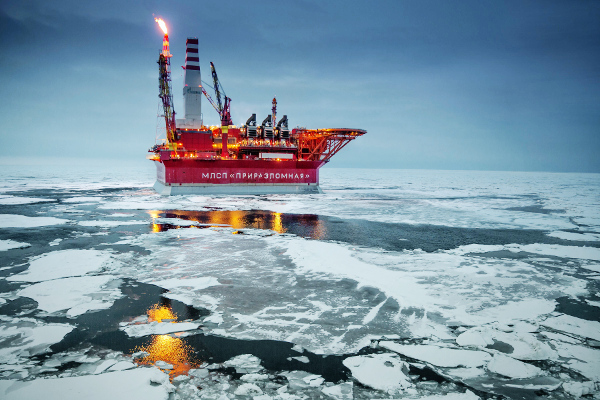Scientists report that with the current global emission rate of 35 to 40 billion metric tonnes of carbon dioxide each year, we may see ice-free summers in the Arctic in the next 20 to 25 years. Although, they differ in their assessment of melting rates, the implication an ice-free Arctic will have on the oil and gas industry mandates an analysis, especially in the light of India’s recent agreement with Russia for a stake in the Arctic oil.
Oil and natural gas are particularly important for the energy hungry Asia-Pacific region. With the Arctic opening up for exploration, drilling in inaccessible and remote areas seem promising. A 2009 USGS probabilistic geology-based assessment of undiscovered oil and gas north of the Arctic Circle states that about 30% of the world’s gas and 13% of oil can be found in this region. Countries with direct access to the Arctic Ocean—USA, Canada, Greenland, Iceland, Norway, Sweden, Finland and Russia and those further away, such as China and India, are likely to exert a significant influence in the drilling for Arctic oil and gas.
For instance, oil and gas from offshore drilling in Norway contributes 22% to the nation’s GDP, and 67% to its exports. In 2017, Norway outranked Qatar to become the second largest global exporter of natural gas, next only to Russia. The oil industry in Norway, however, faces stiff environmental opposition. There were protests, in April, at an Arctic deep water rig site at Hammerfest to stop all drilling activity. In this backdrop, the September 17 gas find by the largest Norwegian oil company, near the Marulk field in the Norwegian Sea is of special importance.
The Arctic resource potential of the USA is second only to Russia’s. However, the USA has been influenced by the 2010 Deepwater Horizon oil spill, and new licenses have been awarded reluctantly. While, a 2017 tax reform bill of the Trump government directs the opening up the National Wildlife Refuge Area for leasing, environmentalists argue that the USA does not need more oil. Industry specialists disagree, citing that production from Alaska has fallen below the 2009 forecast, warning that it takes decades to commission production even after oil and gas are struck.
Russia owns nearly 80% of the oil and gas under the Arctic shelf. However, experts claim that there is a basic mismatch between Russia’s two biggest hydrocarbon companies—Rosneft and Gazprom. The former holds monopoly over Russia’s oil and has the expertise to drill for off-shore oil, while Gazprom, Russia’s gas monopoly largely handles land-based projects. However, Arctic is rich in gas, and not oil, and Gazprom has little experience with Arctic shelf projects. Also, Russia’s policies do not allow for licensing to private companies unless they are at least half owned by the Russian state.
Although these developments are distant from India, the nation’s footprint in the Arctic oil and gas sector is increasing with Indian state-run companies investing $5 billion in various oil projects in the Russian far-east. On September 17 this year, in a new development, a consortium of oil companies in India—IndianOil, ONGC Videsh, Bharat Petro Resources entered into a preliminary agreement for a stake, with Rosenoft, in the Vostok and Eastern Cluster oil projects in the Arctic region. India plans to import oil through a new sea route that would connect Vladivostok with Chennai.
It is interesting to note that of all the Arctic nations, Russia seems to have four key factors that are likely to work for India—largest untapped oil and gas deposits in the Russian part of Arctic; an operable northern sea-route with accelerated Arctic melting opening up shipping opportunities; muted environmental disruptions; and a long history of Indo-Russian collaborations.
But despite a substantial increase in drilling activities in the current decade with the melting of the summer ice in the region, Arctic oil and gas exploration is ridden with challenges ranging from technological hurdles in the freezing environment, to shifts in policy regimes and environmental concerns that overrule industry needs in many nations. Thus, for a number of reasons resources may well go unrecovered and, at present, the drilling for oil and gas is not likely to substantially shift the geographic pattern of world oil production. Several estimates point towards a plateau in global demand by 2023, keeping in mind huge investments in renewable energy. However, for India, which is still substantially coal-driven, dependency on oil and gas shall remain for the next few years, making the Arctic forage a necessity to make India energy secure.
By Sulagna Chattopadhyay
The author is President, SaGHAA (Science and Geopolitics of Himalaya, Arctic and Antarctic), a think tank working on Polar issues
Source: FE
Image Courtesy: Time
You may also like
-
Trade Connect E-platform For Exports Is Single Window, Fast, Accessible And Transformational: Shri Piyush Goyal
-
Dot Simplifies Approval Processes For Telecom Licenses And Wireless Equipment
-
Coal Production and Supply Trends on Positive Trajectory
-
Union Minister To Release Booklets On Promotion Of Indigenous Species & Conservation Of States Fishes
-
2nd India-Japan Finance Dialogue held in Tokyo on 6th September, 2024
